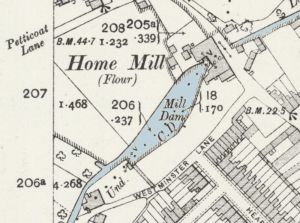Home Mill, Newport
Home Mill, Newport, Isle of Wight stood on the Lukely brook, in Mill Street on the site now (2021) occupied by the McCarthy & Stone flats – Medina Court, Old Westminster Lane and Somers Brook Court, Foxes Road.
In April 1843, Mr. Francis Pittis held an auction at the Bugle Inn including in one lot,
“The Mill drives three pair of stones, and is situated on the well-known Carisbrooke stream, affording at all seasons a regular and abundant supply of water.
“Also, a Close of excellent MEADOW LAND, adjoining the Mill, 1a. 1n., which from the beauty of its situation and its contiguity to the Town and Barracks, offer an eligible opportunity for the erection of one or more Cottage Residences.”[1]
1847 saw the mill on the market again;
In January 1872, a Mr. Arnell operated Home Mill and early one morning the hatches of Westminster Mill, the water mill upstream of Home Mill, were lifted without Home Mill being advised. This resulted in the water overflowing the banks at Home Mill and flooding surrounding areas, road and the ground floor of the Mill. There was reported no reason why the hatches at Westminster Mill should have been opened.[3]
In 1890, Messrs. Arnell Brothers installed ‘modern’ rolling mill equipment by Messrs. Thomas Robinson and Son, of Rochdale in a new building at Home Mill. It was driven by a compound condensing steam engine and power was conveyed to the rolling mill equipment by shaft and gears. The water power could still be used in conjunction with the steam engine when it was available[4]. (For those interested, the article in the Isle of Wight County Press 26 April 1890 gives very detailed guidance for the operation of the roller milling process.)
Ten years later, 1900, the main shaft, which had driven the roller equipment ‘continuously day and night’ at Messrs. Arnell Brothers’ Home Mill suddenly snapped[5]. However, the broken shaft was ‘promptly put right by Mr. G. Perkins, who utilised a torpedo-boat shaft supplied by Messrs. W. White and Sons of Cowes.’[6]
Street Directories record the occupants of Home Mill as:
- 1844 Adams John, Home Mill, Newport
- 1859 Arnell Benjamin, Home Mill - Corn miller
- 1898 Arnell Bros., millers (water & steam), Home mill, Mill street
- 1904 Arnell Brothers, millers (Home Roller mills)
- 1911 Arnell & Son, millers (gas & water), Home Roller mill, Mill street
- 1927 & 1931 Thomas, Gater, Bradfield & Co. Ltd. millers (Home Roller mills)
The Creameries
In the early 1930’s the mill was acquired by Robertons’ & Hallett’s Dairies, a local firm run by Mr. Britten Harvey. The mill was demolished and a dairy was established on the site to process milk from their dairy farms.
In mid 1930’s a number of local business-men and farmers took over the company and towards the end of WW2, Cow and Gate took an interest in the business and the dairy and farms were separated.[7]
Over the years, the name changed as ownership of the site changed hands/branding – Island Dairies, Unigate. In 2000 Unigate merged with Dairy Crest and four years later the Mill Street operation closed with a loss of 37 jobs[8].
The site was subsequently cleared and developed by McCarthy & Stone and David Wilson Homes Ltd.
- ↑ Hampshire Telegraph and Sussex Chronicle – 3 April 1843
- ↑ Hampshire Telegraph 20 February 1847
- ↑ Hampshire Independent – 27 January 1872
- ↑ Isle of Wight County Press - 26 April 1890
- ↑ Isle of Wight County Press - 29 September 1900
- ↑ Isle of Wight County Press - 6 October 1900
- ↑ Isle of Wight County Press - 8 July 1961
- ↑ Isle of Wight County Press - 18 June 2004 & 12 November 2004
